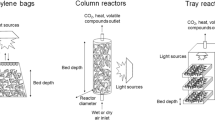Abstract
Four strains of several species of the genusFusarium: F. culmorum, F. sambucinum andF. verticillioides were investigated from the morphological and cultural point of view. To carry out the study two techniques were used : light microscopical and cryogenic scanning electron microscopical observations. The conidiogenous cells formation of all fungi took place inside of false heads from one conidiophore or more. The branched monophialides emerged from the degradation of false heads. HypotheticallyF. culmorum andF. sambucinum no formed microconidia, what was observed that immature conidia in the substrate were consequence of the destruction of the false heads by a bad manipulation of the samples later of their processing. Sporulation of all strains was carried at the water activities of 0.995, 0.98 and 0.95 at both temperatures. The formation structure did not change with the temperature and the water activity of the strains but it was observed that increasing the value numeric of these abiotic factors their development was faster.
Similar content being viewed by others
References
Hope R., Magan N. (2003). Two-dimensional environmental profiles of growth, deoxynivalenol and nivalenol production byFusarium culmorum on a wheat-based substrate. Lett. Appl. Microbiol., 37: 70–74.
Leslie J.F., Summereil .A. (2006). The Fusarium Laboratory Manual. Blackwell Publishing.
Llorens A., Mateo R., Hinojo M.J., Valle-Algarra F.M., Jiménez M. (2004). Influence of environmental factors on the biosynthesis of type B trichothecenes by isolates ofFusarium spp. from Spanish crops. Int. J. Food Microbiol., 94: 43–54.
Marín S., Sanchis V., Magan N. (1995). Water activity, temperature and pH effects on growth ofFusarium moniliforme andF. proliferatum isolates from maize. Can. J. Microbiol., 41: 1063–1070.
Marín, S., Sanchis, V., Rull, F., Ramos, A.J., Magan N. (1998). Colonization of maize grain byFusarium moniliforme andFusarium proliferatum in the presence of competing fungi and their impact on fumonisin production. J. Food Protect., 61: 1489–1496.
Miedaner T., Perkowski J. (1996). Correlations amongFusarium culmorum head blight resistance, fungal colonization and mycotoxin contents in winter rye. Plant Breeding, 115: 347–351.
Picco M., Nesci A., Barros G., Cavaglieri L, Etcheverry M. (1999). Aflatoxin B1 and fumosin B1 in mixed cultures ofAspergillus flavus andFusarium proliferatum on maize. Natural Toxins, 7: 331–336.
Pitt J.I., Hocking A.D. (1999). Fungi and Food Spoilage, 2nd edn., Aspen Publishers, Inc., New York.
Samson R.A., Hoekstra E.S., Frisvad J.C. (2004). Introduction to Food- and Air-Borne Fungi, 7th edn., Centraalbureau voor Schimmelcultures, Utrecht, The Netherlands.
Sempere F., Santamarina M.P. (2006a). Ecofisiología deDrechslera oryzae Subram. & Jain en condicionesin vitro. Phytoma, 178: 49–50.
Sempere F., Santamarina M.P. (2006b). Microscopic and macroscopic study of the interaction betweenAlternaría alternala (Fr.) Keissler andNigrospora oryzae (Berk. & Broome) Petch. Ann. Microbiol., 56: 101–107.
Sempere F., Santamarina M.P. (2007).In vitro biocontrol analysis ofAIternaria alternata (Fr.) Keissler under different environmental conditions. Mycopathologia, 163: 183–190.
Sempere F., Santamarina M.P. (2008). Suppression ofNigrospora oryzae (Berk. & Broome) Petch by an aggressive mycoparasite and competitor,Penicillium oxalicum Currie & Thom. Int. J. Food Microbiol., 122: 35–43.
Sempere F., Roselló P., Santamarina M.P. (2004) Estudio ecofisiológico deFusarium culmorum (G.W. Smith) Sacc. en condicionesin vitro. Phytoma, 162: 49–50.
Sempere F., Roselló J., Santamarina M.P. (2007). Interacciones competitivas entreFusarium sambucinum Fuckel yPhoma glomerata (Corda) Wollenweber & Hochapfel en condicionesin vitro. Rev. Iberoam. Micol., 24: 29–33.
Velluti A., Marín S., Bettucci L, Ramos A.J., Sanchis V. (2000). The effect of fungal competition on colonization of maize grain byFusarium moniliforme, F. proliferatum and F.graminearum and on fumonisin B and zearalenone formation. Int. J. Food Microbiol., 59: 59–66.
Wagacha J.W., Muthomi J.W. (2007).Fusarium culmorum: Infection process, mechanisms of mycotoxin production and their role in pathogenesis in wheat. Crop Prot., 26: 877–885.
Woods D.M., Duniway J.M. (1986). Some effect of water potential on growth, turgor, and respiration ofPhytophtora cryptogea andFusarium moniliforme. Phytopatology, 76 (11): 1248–1254.
Author information
Authors and Affiliations
Corresponding author
Rights and permissions
About this article
Cite this article
Sempere, F., Santamarina, M.P. The conidia formation of severalFusarium species. Ann. Microbiol. 59, 663–674 (2009). https://doi.org/10.1007/BF03179206
Received:
Accepted:
Issue Date:
DOI: https://doi.org/10.1007/BF03179206




